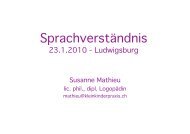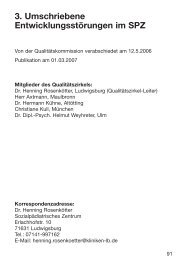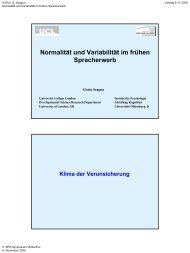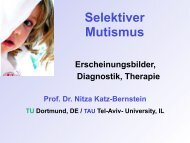(Central) Auditory Processing Disorders - Technical Report
(Central) Auditory Processing Disorders - Technical Report
(Central) Auditory Processing Disorders - Technical Report
- No tags were found...
You also want an ePaper? Increase the reach of your titles
YUMPU automatically turns print PDFs into web optimized ePapers that Google loves.
6 / 2005<br />
American Speech-Language-Hearing Association<br />
a unique role in delineating cognitive-communicative<br />
and language-related factors that may be associated<br />
with (C)APD in some individuals, and in the differential<br />
diagnosis of language processing disorders<br />
from (C)APD. Full understanding of the ramifications<br />
of (C)APD for the individual requires a multidisciplinary<br />
assessment involving other professionals<br />
to determine the functional impact of the<br />
diagnosis and to guide treatment and management<br />
of the disorder and associated deficits; however,<br />
speech-language, psychological, and related measures<br />
cannot be used to diagnose (C)APD.<br />
Because of the individuality of brain organization<br />
and the conditions that affect such organization,<br />
(C)APD can affect individuals differently. Hence, an<br />
individual approach must be taken for the selection<br />
of diagnostic measures and the interpretation of results.<br />
Factors such as chronological and developmental<br />
age; language age and experience; cognitive<br />
abilities, including attention and memory; education;<br />
linguistic, cultural, and social background; medications;<br />
motivation; decision processes; visual acuity;<br />
motor skills; and other variables can influence how a<br />
given person performs on behavioral tests. Many of<br />
these variables also may influence outcomes of some<br />
electrophysiologic procedures as well. Audiologists<br />
should consider the language, cognitive, and other<br />
nonauditory demands of the auditory tasks in selecting<br />
a central auditory diagnostic test battery.<br />
The purpose of a central auditory diagnostic test<br />
battery is to examine the integrity of the CANS, and<br />
to determine the presence of a (C)APD and describe<br />
its parameters. To do this, the audiologist should<br />
examine a variety of auditory performance areas. The<br />
operational definition of (C)APD serves as a guide to<br />
the types and categories of auditory skills and behaviors<br />
that should be assessed during a central auditory<br />
diagnostic evaluation. With children, the neuromaturational<br />
status of the auditory nervous system<br />
should be considered. For both children and adults,<br />
consideration should be given to possible or confirmed<br />
neurologic site of dysfunction, especially in<br />
cases of known neurological disorder. Thus, a central<br />
auditory test battery should provide information<br />
about both developmental and acquired disorders of<br />
the central auditory system.<br />
Test Principles<br />
The following principles should be applied when<br />
determining the composition of a central auditory test<br />
battery. These principles are inherent throughout<br />
much of the literature and are also included in the<br />
ASHA Preferred Practice Patterns, scope of practice<br />
statements, and the Code of Ethics.<br />
1. It is important that the audiologist, who has<br />
the responsibility for administering and interpreting<br />
the auditory processing test battery,<br />
have the knowledge, training, and skills<br />
necessary to do so.<br />
2. The test battery process should not be test<br />
driven; rather, it should be motivated by the<br />
referring complaint and the relevant information<br />
available to the audiologist.<br />
3. Tests with good reliability and validity that<br />
also demonstrate high sensitivity, specificity,<br />
and efficiency should be selected (see Clinical<br />
Decision Analysis below).<br />
4. A central auditory test battery should include<br />
measures that examine different central processes.<br />
5. Tests generally should include both nonverbal<br />
(e.g., tones, clicks, and complex waveforms)<br />
and verbal stimuli to examine<br />
different aspects of auditory processing and<br />
different levels of the auditory nervous system.<br />
Unless tests incorporating verbal stimuli<br />
are available in the individual’s native language,<br />
evaluation may require reliance on<br />
nonverbal stimuli.<br />
6. The audiologist should be sensitive to attributes<br />
of the individual. Attributes may include,<br />
but not be limited to, language<br />
development, motivational level, fatigability,<br />
attention, and other cognitive factors; the influence<br />
of mental age; cultural influences; native<br />
language; and socioeconomic factors.<br />
Individuals who are medicated successfully<br />
for attention, anxiety, or other disorders that<br />
may confound test performance should be<br />
tested under the influence of their medication.<br />
7. The audiologist must review the test normative<br />
information and background carefully to<br />
be sure that the test is appropriate for the individual<br />
to be evaluated.<br />
8. The audiologist should be sensitive to the influences<br />
of mental age on test outcomes.<br />
When testing children below the mental age<br />
of 7 years, task difficulty and performance<br />
variability render questionable results on<br />
behavioral tests of central auditory function.<br />
However, exceptions to this general case may<br />
occur following careful examination of the<br />
task’s requirements and the child’s capabilities<br />
and when using tests specifically designed<br />
for use with younger populations.<br />
Informal assessment, including use of screening<br />
tools as well as periodic follow-up, is rec-







